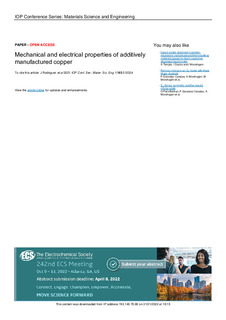| dc.rights.license | Attribution 4.0 International | * |
| dc.contributor.author | Soler Mallol, Daniel | |
| dc.contributor.author | Rodríguez Ceberio, Antonio Javier | |
| dc.contributor.author | Vicente Flores, José Ignacio | |
| dc.contributor.author | Ezeiza, J. C. | |
| dc.contributor.author | Zuriarrain Berasategui, Aitor | |
| dc.contributor.author | ARRAZOLA, PEDRO JOSE | |
| dc.contributor.author | Badiola, Xabier | |
| dc.contributor.author | Dominguez Romero, Erika | |
| dc.date.accessioned | 2022-01-31T16:16:32Z | |
| dc.date.available | 2022-01-31T16:16:32Z | |
| dc.date.issued | 2021 | |
| dc.identifier.issn | 1757-8981 | en |
| dc.identifier.other | https://katalogoa.mondragon.edu/janium-bin/janium_login_opac.pl?find&ficha_no=166112 | en |
| dc.identifier.uri | https://hdl.handle.net/20.500.11984/5452 | |
| dc.description.abstract | Additive Manufacturing (AM) has become the new paradigm of design and production strategies. While structural and functional materials are the most implemented ones, it is also possible to manufacture parts using precious metals, being copper one of the most interesting. Among AM technologies, the novel Atomic Diffusion Additive Manufacturing (ADAM) hasrecently included this material between available ones. ADAM is free from thermal and energetic issues caused by high reflectivity and conductivity of copper which other AM encounter. Therefore, it could be a great alternative to manufacture pure copper. In this work ADAM was used to fabricate pure copper specimens in order to measure electrical and mechanical properties. The influence of a machining post processes in strength and ductility is also discussed. Results are compared with wrought C1 1000 copper and published results of other AM technologies. Despite the newness of ADAM, significant improvement in surface roughness and comparable results in other properties was observed. However, further research shall be done to optimize the manufacturing parameters in order to increase the relative density value, as it was found to be significantly lower than in other AM technologies. | en |
| dc.language.iso | eng | en |
| dc.publisher | IOP Publishing | en |
| dc.rights | © IOP Publishing Ltd | en |
| dc.rights.uri | http://creativecommons.org/licenses/by/4.0/ | * |
| dc.subject | additive manufacturing | en |
| dc.subject | ADAM | en |
| dc.subject | Copper | en |
| dc.subject | Conductivity | en |
| dc.subject | Mechanical | en |
| dc.subject | Machining | en |
| dc.title | Mechanical and electrical properties of additively manufactured copper | en |
| dcterms.accessRights | http://purl.org/coar/access_right/c_abf2 | en |
| dcterms.source | IOP Conference Series: Materials Science and Engineering | en |
| local.contributor.group | Mecanizado de alto rendimiento | es |
| local.description.peerreviewed | true | en |
| local.identifier.doi | https://doi.org/10.1088/1757-899X/1193/1/012034 | en |
| local.source.details | Vol. 1193. N. articulo 012034, 2021 | en |
| oaire.format.mimetype | application/pdf | |
| oaire.file | $DSPACE\assetstore | |
| oaire.resourceType | http://purl.org/coar/resource_type/c_c94f | en |
| oaire.version | http://purl.org/coar/version/c_970fb48d4fbd8a85 | en |








